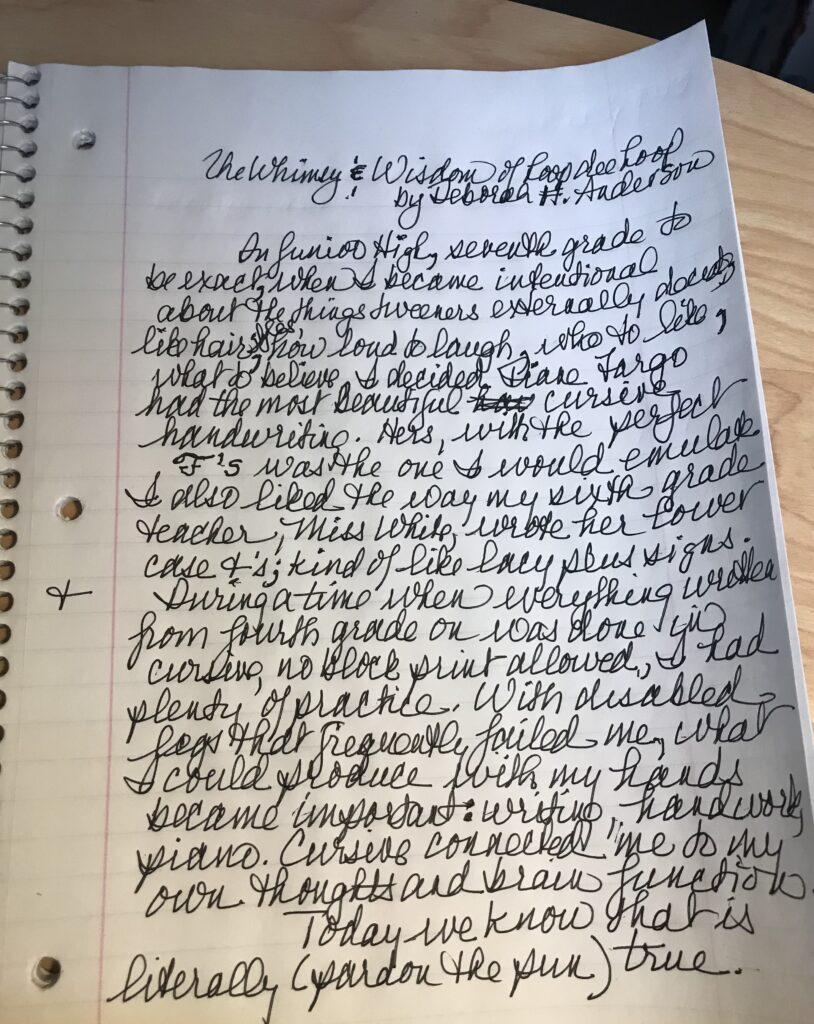By Deborah H. Anderson
In junior high, 7th grade to be exact, I decided that Diane Fargo had the most beautiful cursive handwriting. Hers, with the perfect “F’s,” the top line swooping over the graceful, descending vertical, providing the exact structure for the carefully curved middle horizontal line. So beautiful. Deep sigh.
Yes, hers was the cursive styling I would emulate. I also liked the way my 6th-grade teacher did her lower case “t’s.” Thus, did I fall in love with penmanship. Cursive, to be exact.
During a time when everything written from 4th grade on was done in cursive, no block print allowed, I had plenty of practice. With disabled legs and feet that frequently failed me, what I could produce with my hands became important: writing, handwork, and piano. Cursive connected me to my own thoughts and brain function in a way that was affirming and empowering.
Today, we know that this is literally (pardon the pun) true. According to developmental neuroscience researchers, “Even if students use digital pens and write by hand on an interactive computer screen, cursive handwriting helps the brain learn and remember better.”
Using a high-density electroencephalogram on 12-year-olds and young adults, researchers found that, “… cursive handwriting primed the brain for learning by synchronizing brain waves in the theta rhythm range (4-7Hz), and stimulated more electrical activity in the brain’s parietal lobe and central regions.” The authors went on to say that this kind of “oscillatory neuronal activity” is important for both memory and encoding new information. Scientists have found a further connection to enhanced reading acuity.
For me, cursive is like dancing with my hands. From the very first exercise of making continuous loop lines of “Os” slanted gently to the right (as a right-hand dominant person) – such that they touched a top and bottom line equidistant from each other, measured by a dotted middle line – a place of beauty and grace opened in my heart and creative spirit.
Frequently, in the years to come, I heard “You have lovely handwriting.” While I could critique my flaws in spacing and size, I just say “thank you,” knowing I am preserving an archaic tradition and practice. Inside, I know my handwriting will never be as beautiful as Diane’s.
To this day, with this article as an example, most of my first-draft writing is done in cursive in spiral notebooks. Each project or piece has its own gel pen color and nib size that reflects back to me the tone I’m intending. This was composed in black gel with a .07 nib.
Last week, my best cursive story yet happened in the University Village Apple store. My phone had been distressed for over two years. With no viable solution save shelling out $795 for a new iPhone 12 plus, I was directed to a young twenty-something Russian immigrant from Siberia. After an awkward moment when I mentioned I had to have the phone restored because I was in daily contact with friends-like-family in Kyiv, he plugged my phone into a computer, confident it was an easy fix.
In the next 20 minutes, while the phone whirled away with corrective activity, the conversation wandered into the deadline for this column. Excited when I mentioned the word “cursive,” he shared his similar passion. He launched into an exposition on Cyrillic, Chinese, and Turkish cursive. How had I not ever considered that other languages also had cursive versions? Into the lovely unknown once more.
He had a theory that cursive was disappearing in this country because it is too hard for immigrants to learn, on top of everything else they have to learn, from the starting point of so many languages. I’ve had my theories as well. When technology entered education, it was quite the unknown, shiny thing. During the dot-com bubble, learning to type took precedence over learning handwriting, and cursive was pushed off the radar of necessary skills for adulthood, or life.
Typing eventually only needed two thumbs. But our brains, and eyes, and all the points in between need what cursive offers. And the parts of our body we’ve lost with using just two thumbs need to be restored. With all my heart, as a writer and an educator, I believe it is time to bring back teaching that 3rd-grade rite of passage – cursive.
My phone was restored and renewed. An international moment of peacemaking occurred while a young Russian man helped me connect to friends in Kyiv.
Writing all this has renewed my passionate commitment to bringing back cursive in our schools. It’s essential for brain growth. Essential. Let’s not cheat future generations out of better, more artistic, learning and reading skills.

